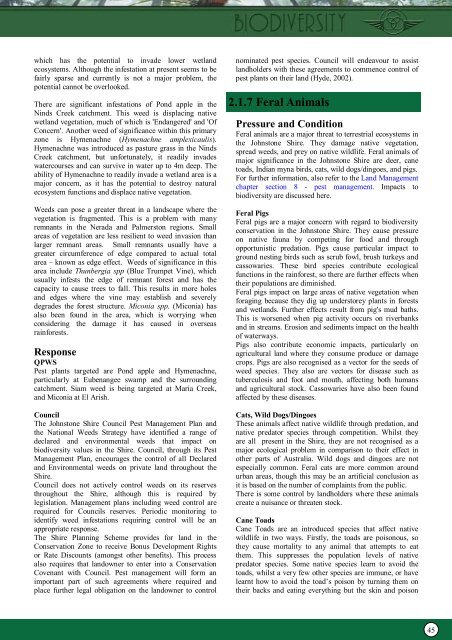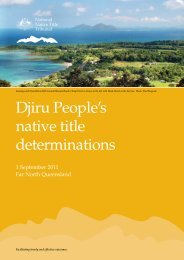Biodiveristy_State of Environment report - Mission Beach Cassowaries
Biodiveristy_State of Environment report - Mission Beach Cassowaries
Biodiveristy_State of Environment report - Mission Beach Cassowaries
- No tags were found...
You also want an ePaper? Increase the reach of your titles
YUMPU automatically turns print PDFs into web optimized ePapers that Google loves.
which has the potential to invade lower wetlandecosystems. Although the infestation at present seems to befairly sparse and currently is not a major problem, thepotential cannot be overlooked.There are significant infestations <strong>of</strong> Pond apple in theNinds Creek catchment. This weed is displacing nativewetland vegetation, much <strong>of</strong> which is 'Endangered' and 'OfConcern'. Another weed <strong>of</strong> significance within this primaryzone is Hymenachne (Hymenachne amplexicaulis).Hymenachne was introduced as pasture grass in the NindsCreek catchment, but unfortunately, it readily invadeswatercourses and can survive in water up to 4m deep. Theability <strong>of</strong> Hymenachne to readily invade a wetland area is amajor concern, as it has the potential to destroy naturalecosystem functions and displace native vegetation.Weeds can pose a greater threat in a landscape where thevegetation is fragmented. This is a problem with manyremnants in the Nerada and Palmerston regions. Smallareas <strong>of</strong> vegetation are less resilient to weed invasion thanlarger remnant areas. Small remnants usually have agreater circumference <strong>of</strong> edge compared to actual totalarea – known as edge effect. Weeds <strong>of</strong> significance in thisarea include Thunbergia spp (Blue Trumpet Vine), whichusually infests the edge <strong>of</strong> remnant forest and has thecapacity to cause trees to fall. This results in more holesand edges where the vine may establish and severelydegrades the forest structure. Miconia spp. (Miconia) hasalso been found in the area, which is worrying whenconsidering the damage it has caused in overseasrainforests.ResponseQPWSPest plants targeted are Pond apple and Hymenachne,particularly at Eubenangee swamp and the surroundingcatchment. Siam weed is being targeted at Maria Creek,and Miconia at El Arish.CouncilThe Johnstone Shire Council Pest Management Plan andthe National Weeds Strategy have identified a range <strong>of</strong>declared and environmental weeds that impact onbiodiversity values in the Shire. Council, through its PestManagement Plan, encourages the control <strong>of</strong> all Declaredand <strong>Environment</strong>al weeds on private land throughout theShire.Council does not actively control weeds on its reservesthroughout the Shire, although this is required bylegislation. Management plans including weed control arerequired for Councils reserves. Periodic monitoring toidentify weed infestations requiring control will be anappropriate response.The Shire Planning Scheme provides for land in theConservation Zone to receive Bonus Development Rightsor Rate Discounts (amongst other benefits). This processalso requires that landowner to enter into a ConservationCovenant with Council. Pest management will form animportant part <strong>of</strong> such agreements where required andplace further legal obligation on the landowner to controlnominated pest species. Council will endeavour to assistlandholders with these agreements to commence control <strong>of</strong>pest plants on their land (Hyde, 2002).2.1.7 Feral AnimalsPressure and ConditionFeral animals are a major threat to terrestrial ecosystems inthe Johnstone Shire. They damage native vegetation,spread weeds, and prey on native wildlife. Feral animals <strong>of</strong>major significance in the Johnstone Shire are deer, canetoads, Indian myna birds, cats, wild dogs/dingoes, and pigs.For further information, also refer to the Land Managementchapter section 8 - pest management. Impacts tobiodiversity are discussed here.Feral PigsFeral pigs are a major concern with regard to biodiversityconservation in the Johnstone Shire. They cause pressureon native fauna by competing for food and throughopportunistic predation. Pigs cause particular impact toground nesting birds such as scrub fowl, brush turkeys andcassowaries. These bird species contribute ecologicalfunctions in the rainforest, so there are further effects whentheir populations are diminished.Feral pigs impact on large areas <strong>of</strong> native vegetation whenforaging because they dig up understorey plants in forestsand wetlands. Further effects result from pig's mud baths.This is worsened when pig activity occurs on riverbanksand in streams. Erosion and sediments impact on the health<strong>of</strong> waterways.Pigs also contribute economic impacts, particularly onagricultural land where they consume produce or damagecrops. Pigs are also recognised as a vector for the seeds <strong>of</strong>weed species. They also are vectors for disease such astuberculosis and foot and mouth, affecting both humansand agricultural stock. <strong>Cassowaries</strong> have also been foundaffected by these diseases.Cats, Wild Dogs/DingoesThese animals affect native wildlife through predation, andnative predator species through competition. Whilst theyare all present in the Shire, they are not recognised as amajor ecological problem in comparison to their effect inother parts <strong>of</strong> Australia. Wild dogs and dingoes are notespecially common. Feral cats are more common aroundurban areas, though this may be an artificial conclusion asit is based on the number <strong>of</strong> complaints from the public.There is some control by landholders where these animalscreate a nuisance or threaten stock.Cane ToadsCane Toads are an introduced species that affect nativewildlife in two ways. Firstly, the toads are poisonous, sothey cause mortality to any animal that attempts to eatthem. This suppresses the population levels <strong>of</strong> nativepredator species. Some native species learn to avoid thetoads, whilst a very few other species are immune, or havelearnt how to avoid the toad’s poison by turning them ontheir backs and eating everything but the skin and poison45



